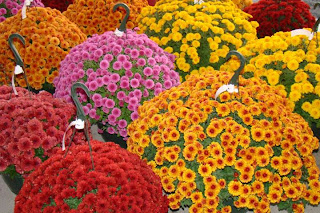JANUARY GARDENING
After
a busy holiday season, all you might want to do now is curl up in front of the
fireplace with some hot chocolate and a book. So, go ahead and enjoy! The rush of the holidays is over, so relax and enjoy the
beauty of winter and those holiday plants.
And speaking of those holiday plants, would you
love to keep them beautiful all winter or longer but think only truly green
thumbs can achieve that? Not so!
Instead, holiday plants might open the door to the enjoyment and pleasure of
nurturing other plants indoors throughout the winter. Just remember a green thumb is simply a positive state of
mind. Learn the plant care needs
of your plant. Most care tags will
include the light, temperature, humidity and watering needs. For example:
POINSETTIA CARE:
• For the best coloration and health,
place in a sunny window (west or south exposure).
• Avoid both cold drafts and drying heat
from vents or fireplaces.
• Maintain the temperature range of 55° F
to 70° F.
• Maintain a moist, not soggy, soil and
check every day.
• When the soil surface feels dry, add
water until it begins to collect in the plant saucer. Discard any excess water to avoid
root rot problems.
• Do not let the soil complete dry out.
Enjoy your holiday plants and remember, don’t
panic! With a little forethought,
preparation and observance on your part, a new plant can become a challenging
project rather than a predetermined failure. No matter the color of your thumb in the past, with proper
are, several holiday plants are capable of ringing in many new years to come.
But
wait, there’s more! While you
are relaxing in front of the fireplace, pick up that new seed catalog!
Now is the best time to plan for your new
bigger and better spring garden. If you have saved photos from last year’s garden, dig them
out and use them to help lay out any changes you talked about making last
year. Make a sketch of last year’s
planting areas and add to them with your pencil what you would like for this
year and make a list of what you need to buy. This effort will help tremendously as you peruse those
catalogs. Do remember to order from
catalogs that originate from your area.
You will achieve much better results from seeds and plants that are
propagated and grown in and for your area.
TOM’S TIMELY TIPS FOR JANUARY
• When using salt to melt ice on walks and
driveways, spread it carefully to avoid
damage to nearby shrubs consider using sand or sawdust instead.
• Brush
snow from evergreens in an upward, sweeping motion. Serious damage may be caused by heavy snow or ice
accumulating on the branches.
• Turn and prune house plants regularly to keep
them shapely. Pinch back new growth to promote bushy plants.
• Houseplants should not be placed on top of the
television. This location is too
warm and in most homes too far from windows to provide adequate light.
• Now is the time to feed the birds in your
landscape for natural food sources are scarce at this time of years. Use suet cakes along with birdseed to
provide protein and fat for birds.







